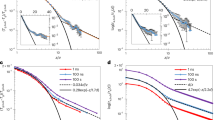Abstract
Interaction of mobile disclinations in the liquid crystalline state results in various disclination arrays. The mesophase state of liquid crystalline polymer (LCPs) samples has been assumed to consist of a polydomain texture, each domain having an internal structure of uniform orientation bounded by regions where the molecular director field undergoes reorientation from one domain to its neighbour. However, the detailed nature of the boundary region (in particular whether the molecular director reorients in a continuous or discontinuous fashion) is largely unknown. We have observed groupings of disclinations of alternating sign which resemble Bouligand's serrated wall structure1 and ‘foursomes’ of two positive and two negative disclinations which bear a likeness to the ‘effective domain’ structure recently hypothesized by Marrucci2 to account for certain rheological aspects of LCPs. The arrangements of disclinations in our thin-film samples give rise to an apparent polydomain texture consisting of regions of uniform molecular orientation bounded by disclinations where the molecular director undergoes continuous rotation about an axis parallel to the disclination lines (Neel walls). The specific disclination arrays observed will be influenced by the molecular weight and stiffness constants of the particular LCP and by the flow history, thickness and boundary conditions of the film3; nevertheless, except in the vicinity of the disclination cores, the field of molecular director trajectories throughout the polydomain sample texture is both continuous and translationally parallel.
This is a preview of subscription content, access via your institution
Access options
Subscribe to this journal
Receive 51 print issues and online access
$199.00 per year
only $3.90 per issue
Buy this article
- Purchase on Springer Link
- Instant access to full article PDF
Prices may be subject to local taxes which are calculated during checkout
Similar content being viewed by others
References
Bouligand, Y. J. Phys. 34, 604–614 (1973).
Marrucci, G. Proc. IX Int. Congr. Rheol. (University of Mexico, 1984).
Kleman, M. JCS Faraday Discuss. 79, 215–224 (1985).
Donald, A. M., Viney, C. & Windle, A. H. Phil. Mag. B52, 925–941 (1985).
Asada, T. & Onogi, S. Polym. Engng Rev. 3, 324–353 (1983).
Wissbrun, K. JCS Faraday Discuss. 79, 161–173 (1985).
Graziano, D. J. & Mackley, M. Molec. Cryst. Liq. Cryst. 106, 73–93 (1984).
Asada, T., Onogi, S. & Yamase, H. Polym. Engng Sci. 24, 355–360 (1984).
Thomas, E. L. & Wood, B. A. JCS Faraday Discuss. 79, 229–239 (1985).
Wood, B. A. thesis, Univ. Massachusetts-Amherst (1985).
Frank, F. C. JCS Faraday Discuss. 79, 274–280 (1985).
Frank, F. C. JCS Faraday Discuss. 25, 19–28 (1958).
Lehmann, O. Die Lehre von den flussigen Krystallen (Bergman, Wiesbaden 1918).
Author information
Authors and Affiliations
Rights and permissions
About this article
Cite this article
Wood, B., Thomas, E. Are domains in liquid crystalline polymers arrays of disclinations?. Nature 324, 655–657 (1986). https://doi.org/10.1038/324655a0
Received:
Accepted:
Issue Date:
DOI: https://doi.org/10.1038/324655a0
This article is cited by
-
Diffraction imaging of nanocrystalline structures in organic semiconductor molecular thin films
Nature Materials (2019)
-
Effect of the lateral substituent on the mesomorphic behavior of side-chain liquid-crystalline polymers containing a Schiff base ester
Journal of Polymer Research (2013)
-
Decoration of disclinations by solidification-induced band texture and focal-conic texture for a low-molar-mass liquid crystal
Chinese Science Bulletin (2002)
-
Band-texture decorated spatial distribution of molecular orientation around air bubbles in hydroxypropyl cellulose aqueous solution
Polymer Bulletin (1996)
-
Thermodynamic transition properties of highly ordered smectic phases
Journal of Thermal Analysis (1996)
Comments
By submitting a comment you agree to abide by our Terms and Community Guidelines. If you find something abusive or that does not comply with our terms or guidelines please flag it as inappropriate.



